Recent Posts
Flooding
5/23/2023 (Permalink)
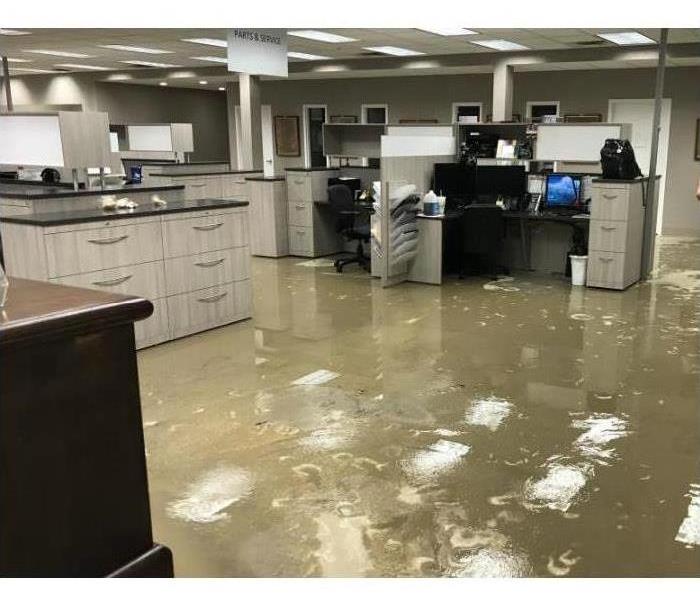 This flooded office was from a recent storm.
This flooded office was from a recent storm.
Water damage cleanup processes at commercial properties can present unexpected dangers, which should not be underestimated. It is crucial to take proper precautions to ensure safety. Our water damage restoration professionals at SERVPRO of Dubuque recommend the following simple precautions during water damage cleanup to keep you safe in the event of a flood at your business:
Stay out until it's safe: It is best to avoid reentering your business until it has been declared safe by SERVPRO of Dubuque's technicians. Various hazards such as water contamination, structural damage, mold growth, and electrocution may be present. If reentering is necessary, make sure to wear appropriate protective gear to ensure safety.
Be prepared for potential hazards: During the water damage cleanup process, complications can arise. While not all of them may occur after a flood, being prepared for each possibility is important. This includes being aware of potential issues such as collapsed walls or roofs, gas leaks, compromised electrical systems, and pest infestations.
Use proper protective gear: Floodwater often contains hazardous bacteria and microorganisms. If you must reenter your business, it is crucial to wear appropriate protective gear. Depending on the extent of the damage, this may include respiratory protection, rubber gloves, rubber boots, Tyvek coveralls, and other necessary equipment.
Prompt water removal: The water should be removed as soon as possible to minimize mold growth and water damage. SERVPRO of Dubuque has trained technicians and the right equipment to efficiently remove the water and dry your facilities. Swift action in this regard helps mitigate potential safety hazards.
Avoid procrastination: It is important not to delay the cleanup process, regardless of other distractions or tasks at hand. Mold and water damage pose their own safety risks, so prioritize the cleanup to prevent further damage and potential health hazards.
By following these precautions, you can enhance safety during water damage cleanup at your commercial property.
Yearly Inspection
5/23/2023 (Permalink)
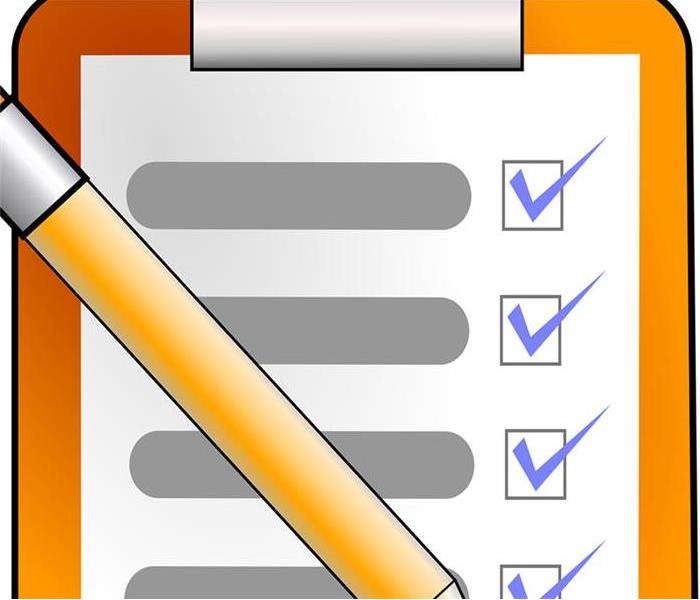 This is showing that it was inspected for the year.
This is showing that it was inspected for the year.
Water damage is an unpredictable and costly issue that many homes and buildings face. It is estimated that almost all homes with basements in the US will experience water damage at some point, resulting in annual costs of up to $13 billion. Unlike fire damage, water damage often remains hidden until the damage has already occurred, making it even more challenging to address. To protect yourself and your home from water damage and avoid expensive repairs, prevention is key.
Performing regular inspections and maintenance is crucial in detecting early signs of water damage. Check for any indications of water leaks, such as damp areas or discoloration on walls, floors, and ceilings. The presence of mold or mildew is often an indicator of a water source nearby. Inspect the plumbing system that connects to appliances like water heaters, dishwashers, washing machines, and refrigerators for any signs of leakage. Develop a habit of shutting off the water supply when going on vacation.
Maintaining the exterior of your property is equally important. Water damage can originate from internal or external sources, so it's essential to check areas where water may enter, including windows, doors, and downspouts. Inspect the roof for missing or damaged shingles and ensure that gutters are clear of debris to allow proper rainwater drainage. Seal any cracks or gaps to prevent water seepage.
As the saying goes, "It's better to be safe than sorry." Prepare for unforeseen events by storing valuable items, important documents, and seasonal belongings in waterproof containers. Consider investing in a water sensor for early leak detection, providing timely notifications in case of water leakage.
If water has already penetrated your home, it is advisable to seek professional assistance from SERVPRO of Dubuque. Their expertise and specialized tools, including water extraction systems, can swiftly remove water and minimize further damage. Acting promptly can prevent the spread of damage and aid in the effective restoration of your property.
By following these precautions and taking proactive measures, you can mitigate the risks of water damage and safeguard your home or business.
Commercial Water Damage
5/23/2023 (Permalink)
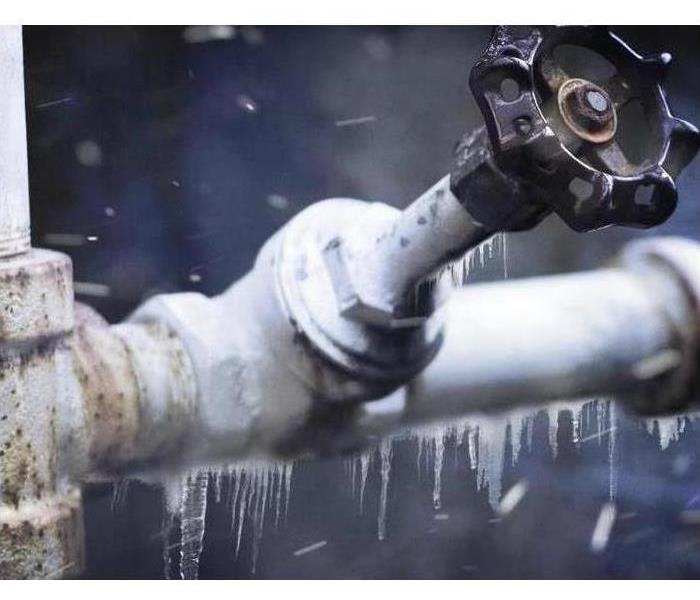 This pipe is frozen and could bust causing water damage in your commercial building.
This pipe is frozen and could bust causing water damage in your commercial building.
The piping systems in many older commercial buildings often pose a significant risk due to their deteriorating condition. What was once considered state-of-the-art during installation may now be recognized as problematic or due for replacement. Unfortunately, commercial property owners tend to overlook the condition of these hidden pipes until a leak occurs, resulting in water damage, tenant displacement, and the potential growth of mold.
Various types of older piping can be a cause for concern. Polybutylene piping, popular between the 1970s and 1990s due to its cost-effectiveness and easy installation, has proven to be problematic. Exposure to water treatment chemicals like chlorine causes it to become brittle and prone to breakage. Even if the piping remains intact, water quality is compromised as chemicals leach into the water, necessitating its replacement.
Cast iron or galvanized metal piping is susceptible to erosion, corrosion, or a combination of both. The friction caused by water flow within the pipes leads to erosion, wearing away the metal over time. Corrosion occurs when the metal chemically reacts with water, posing an even greater challenge for metal piping. Galvanized iron piping, for instance, which involved coating steel with zinc, was commonly used in structures built before 1960. However, zinc erodes and corrodes over time, leading to reduced water flow, increased leak risk, and compromised water quality. Galvanized pipes generally have a reliable lifespan of about 25 years.
In newer commercial buildings, stainless steel and copper piping may be used if the construction budget allows for it. Plastic plumbing types like PEX, PVC, and CPVC are also common in newer installations. While durable and flexible, they come with their own challenges, such as vulnerability to freezing conditions or UV degradation. It's important to note that no piping material is immune to deterioration, as none of them last indefinitely.
If you ever experience water damage resulting from pipe failure, you can rely on the services of SERVPRO of Dubuque to restore your property to its pre-damaged state. Their expertise and dedication will ensure that the water damage is addressed professionally, leaving no trace of the incident.
How many chargers do you have?
5/23/2023 (Permalink)
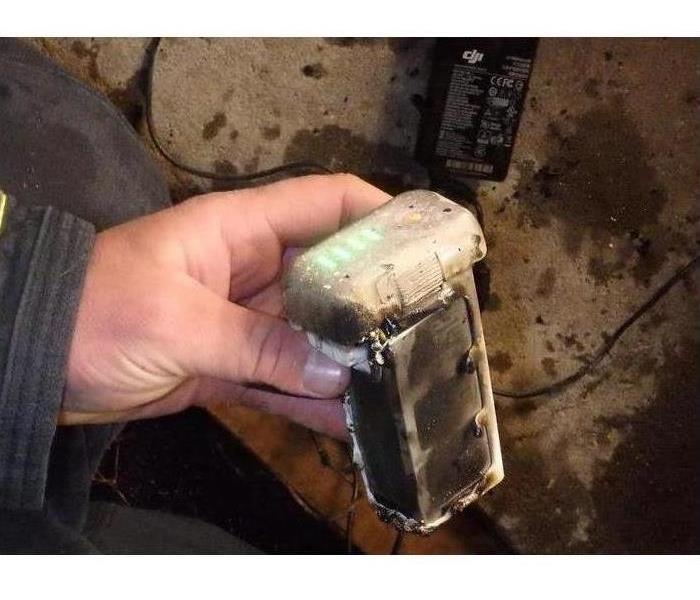 This shows that the charger started on fire.
This shows that the charger started on fire.
How many chargers do you currently have plugged in at your home or office? Between phone chargers, tablet chargers, and various gaming console accessories, it's not uncommon to have several plugged in simultaneously.
But did you know that even when your devices are not connected and actively charging, the wall plugs for these chargers still have power running through them?
While it's widely known that charging a phone on a flammable surface like a bed or sofa can be a fire hazard, many people are unaware that once the phone or charging cord is disconnected, the wall plug continues to draw power.
With the increasing use of mobile electronics in our daily lives, most of us have multiple chargers for our cell phones, tablets, and other accessories. It's common to leave these chargers plugged in and simply disconnect the devices when not in use. However, this practice poses a significant fire hazard and has become one of the leading causes of electrical fires in homes.
To mitigate this risk, there are two preventative measures you can take. One option is to unplug all chargers when they are not actively charging devices. Alternatively, you can plug all chargers into a high-quality GFI power strip and turn it off when the chargers are not in use.
By following these safety precautions, you can reduce the chances of a dangerous and costly fire in your home or business. And in the unfortunate event of a fire or water damage, please remember that SERVPRO of Dubuque is here to help. We specialize in restoring properties to their pre-damaged condition and making it "Like it never even happened."
Different Kinds of Storms in Winter
5/23/2023 (Permalink)
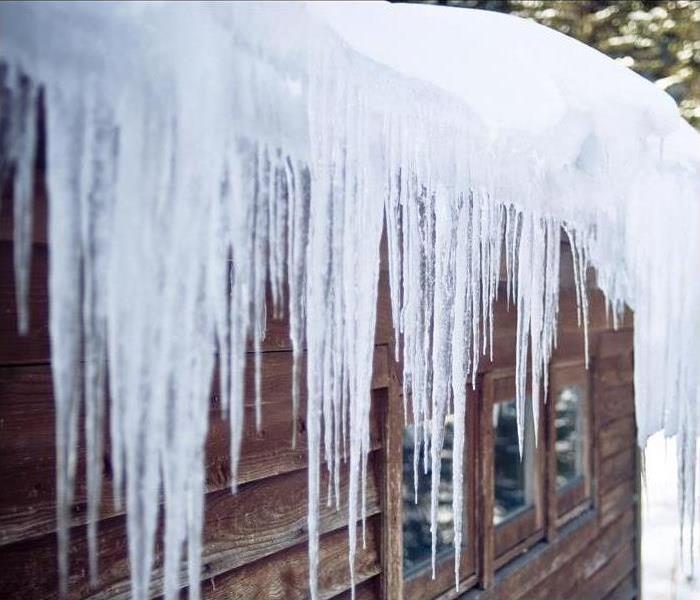 This shows an example of an ice dam on a home.
This shows an example of an ice dam on a home.
When thinking of heavily damaged property, most people associate it with summer storms. However, it's important to note that different types of winter storms can also cause a wide range of damage.
Blizzards, for example, are dangerous winter storms characterized by blowing snow and strong winds. Along with heavy snowfall and severe cold, blizzards can lead to roof collapse due to the weight of accumulated snow. This can result in structural damage and water damage from melting snow. If not addressed promptly, moisture left behind can also cause mold problems. If you require assistance with damage assessment, cleanup, and repairs, SERVPRO of Dubuque can provide the necessary services.
Snow squalls, on the other hand, are intense snow showers accompanied by gusty winds. They can cause significant snow accumulation and drifting. It's crucial to monitor your furnace exhaust vents during such conditions to ensure they remain clear and the furnace vents safely to the outside.
Ice dams are another winter storm phenomenon caused by melting snow. They can lead to water entering your home through the attic when snow melts and refreezes at the eaves instead of running off through the gutters. Proper attic insulation and ventilation are essential to prevent this issue.
Ice and sleet storms pose unique challenges as well. Ice build-up on power lines can cause service outages lasting for hours or even days. In such cases, depending on the outside temperature, it may be wise to shut off your water and drain the pipes to prevent freezing and subsequent damage.
Additionally, ice build-up on trees can cause branches to break and fall on your home, potentially causing significant damage. To minimize this risk, it's recommended to have your trees professionally pruned, which reduces the likelihood of branches causing harm.
In the event that winter storms damage your home, remember that SERVPRO of Dubuque is available to restore your property to its pre-damaged condition. We strive to make it "Like it never even happened."
Fires, Smoke, Soot
5/23/2023 (Permalink)
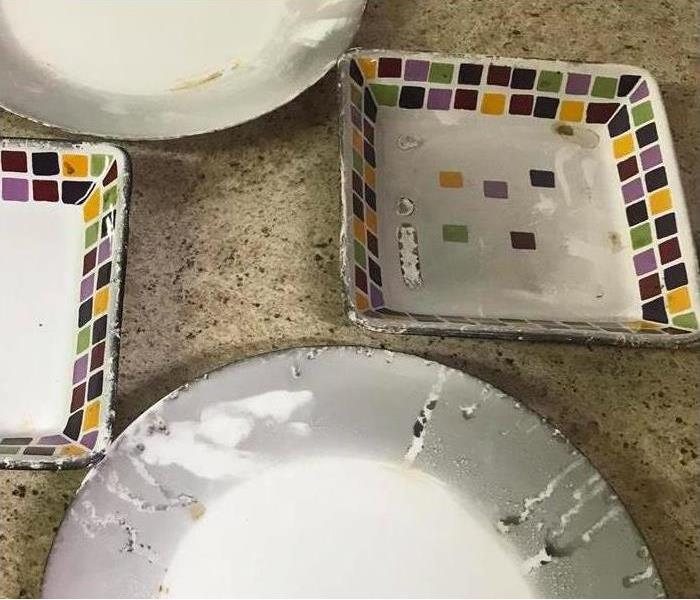 These dishes were in a kitchen fire and were salvageable.
These dishes were in a kitchen fire and were salvageable.
Fires, whether in residential or commercial settings, can result in smoke, soot, and odor that can penetrate various areas of a building, causing hidden damage. At SERVPRO of Dubuque, we specialize in smoke and soot damage restoration. Our expertise allows us to inspect the affected areas, accurately assess the extent of the damage, and develop a comprehensive plan of action for restoration.
Smoke, soot, and odor behavior:
- Hot smoke tends to rise to upper levels of a structure and is also attracted to cooler surfaces.
- Smoke can flow through the home, permeating cavities and using openings such as pipe and electrical runs to travel between floors.
- The restoration process can be influenced by the type of smoke and soot present.
- The approach to eliminating odors may vary depending on the specific type of smoke.
Different types of smoke:
There are two main types of smoke: wet smoke and dry smoke. The type of smoke determines the characteristics of the soot residue left behind after a fire. Before initiating restoration, our team at SERVPRO of Dubuque can perform pretesting to identify the type of smoke involved. This information helps us plan and implement the most effective cleaning procedures.
- Wet Smoke (Plastic and Rubber): This type of smoke results from low heat, smoldering fires and produces a pungent odor. Soot from wet smoke tends to migrate horizontally, is sticky, and smears easily. Cleaning smoke webs can be more challenging.
- Dry Smoke (Paper and Wood): Dry smoke is generated by fast-burning fires with high temperatures. Heat rises, causing the smoke to ascend. Dry smoke produces lighter soot that is less likely to be sticky or smear.
Smoke odor removal:
In addition to the physical cleaning process, SERVPRO of Dubuque utilizes various specialized machines to mitigate smoke odors. Examples of these machines include ozone machines, hydroxyl machines, and HEPA air filtration devices with activated carbon/charcoal filters.
Our fire damage restoration services:
Each fire loss is unique and requires a customized solution tailored to the specific conditions. SERVPRO of Dubuque is equipped with the necessary equipment, expertise, and experience to restore your property after fire, smoke, and soot damage. We prioritize treating your family with empathy and respect while caring for your property.
If you experience a fire, smoke, or soot-related loss, reach out to the fire damage professionals at SERVPRO of Dubuque. We are committed to ensuring that the restoration process makes it "Like it never even happened."
Commercial VS Residential
5/23/2023 (Permalink)
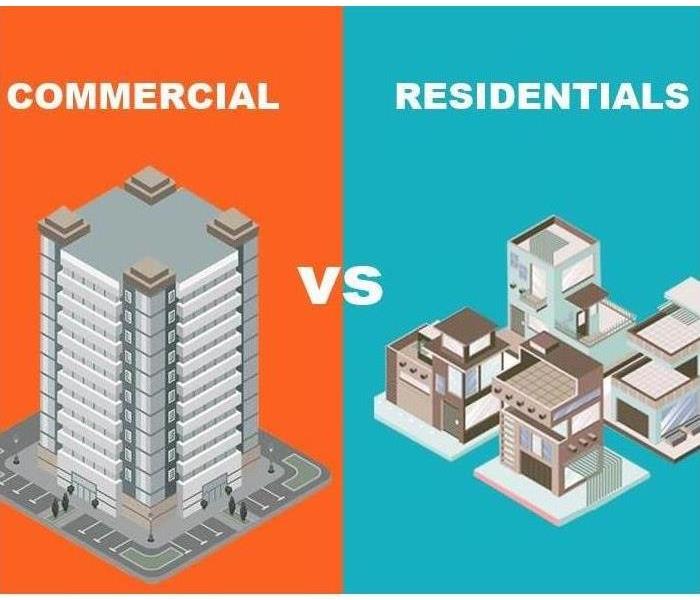 This photo shows Commercial VS Residential buildings.
This photo shows Commercial VS Residential buildings.
Commercial water damage differs significantly from residential damage due to the nature of the buildings involved. Commercial properties are generally larger in size, which means there is often a greater volume of water involved. Additionally, commercial buildings are utilized for business purposes, further complicating the impact of water damage. While there are similarities, it is crucial to understand the distinct factors and considerations associated with commercial water damage compared to residential situations. Moreover, the water damage restoration process varies between these two property types.
Water damage restoration in a commercial property shares similarities with residential cleanup, but it often operates on a larger scale. In commercial settings, timing is of utmost importance when dealing with water damage. Have you ever encountered a minor pipe leak or a clogged toilet that you chose to ignore? Unfortunately, such negligence can lead to a burst pipe or overflowing toilet, causing extensive water damage. If you are a property manager or owner of a commercial property, it is crucial not to delay addressing issues like leaky pipes or clogged toilets. Commercial water damage tends to escalate more rapidly than residential damage due to the larger building size, increased water usage, and other potential risks. Therefore, contacting water damage restoration professionals, such as SERVPRO of Dubuque, becomes critical to mitigate the damage effectively.
Immediate action should be taken to commence the processes of extraction, drying, and disinfection. While some individuals may attempt to carry out these tasks independently, it is best for your business and its interests to entrust the cleanup to experts. When these steps are not executed properly or promptly enough, the risk of mold growth intensifies the damage and escalates repair costs. Moreover, extensive water damage can cause a decrease in the value of your commercial property. Furthermore, the longer the cleanup process takes, the more it disrupts your business and affects customers. To save time, avoid hassles, and ensure a thorough restoration, it is advisable to address the water damage promptly with the assistance of water damage restoration experts like SERVPRO of Dubuque. Their expertise will make the restoration process "Like it never even happened."
ERP- Emergency Ready Plan
5/23/2023 (Permalink)
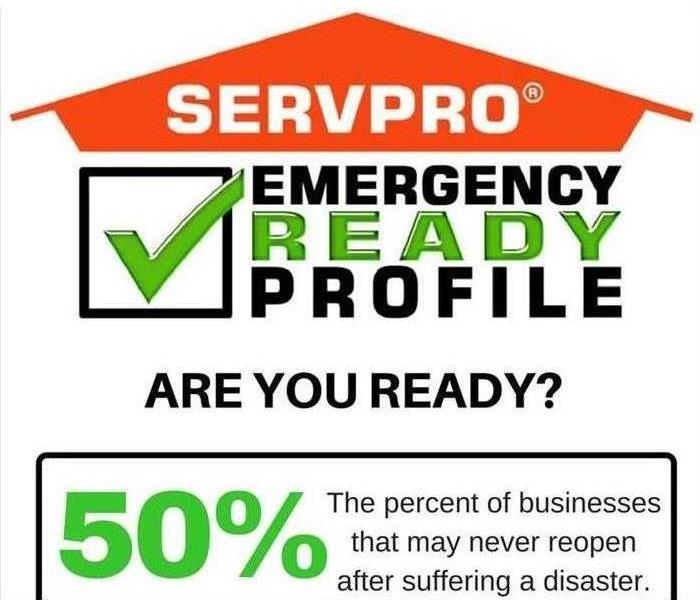 Emergency Ready Plan other known as ERP
Emergency Ready Plan other known as ERP
An Emergency Ready Plan is a valuable tool that every commercial property should have. Disasters can strike at any time, and it's crucial to be prepared. Imagine if an emergency occurs in the middle of the night when maintenance staff may not be available. This is especially critical for properties such as apartment complexes, where having emergency information readily accessible on-site is essential.
So, what exactly is an Emergency Ready Plan?
It is a complimentary assessment of your facility conducted by our team. We will create a comprehensive document that contains only the critical information needed during an emergency. This includes essential details about your facility, such as the locations of shut-off valves, priority areas, and crucial contact information. The plan will also outline the best access points to the building and optimal locations for emergency vehicles and equipment placement. Creating this plan will only require a small amount of your time and will not interfere with your other responsibilities. However, it will prove invaluable if an emergency arises. Essentially, it serves as a guide to help you quickly recover and get back into your building following a disaster. By having an immediate plan of action, you can minimize the downtime of your business.
Additionally, the Emergency Ready Plan establishes SERVPRO of Dubuque as your trusted disaster mitigation and restoration provider. As an industry leader with a local presence, we are well-equipped to handle any emergency situation efficiently. The plan also clearly identifies the line of command for authorizing work to begin. This streamlined communication saves precious time, enabling us to promptly initiate the mitigation process, ultimately saving you both time and money.
Having a readily available reference guide that outlines what to do, how to do it, and who to contact in case of an emergency provides proactive solutions. This means that even before an emergency occurs, you are "Ready for whatever happens." Moreover, by signing a call first agreement with SERVPRO of Dubuque, you can establish a preauthorized amount of funds. This ensures that we can commence the necessary work immediately in the event of a loss. As part of this agreement, you also gain access to preferential pricing and priority service during a major disaster in your community.
Rest assured that SERVPRO of Dubuque will handle the restoration process with expertise, making it "Like it never even happened." By having an Emergency Ready Plan in place, you are taking a proactive step to protect your commercial property and ensure a swift and efficient response in times of crisis.
Different Classes of Fires
5/23/2023 (Permalink)
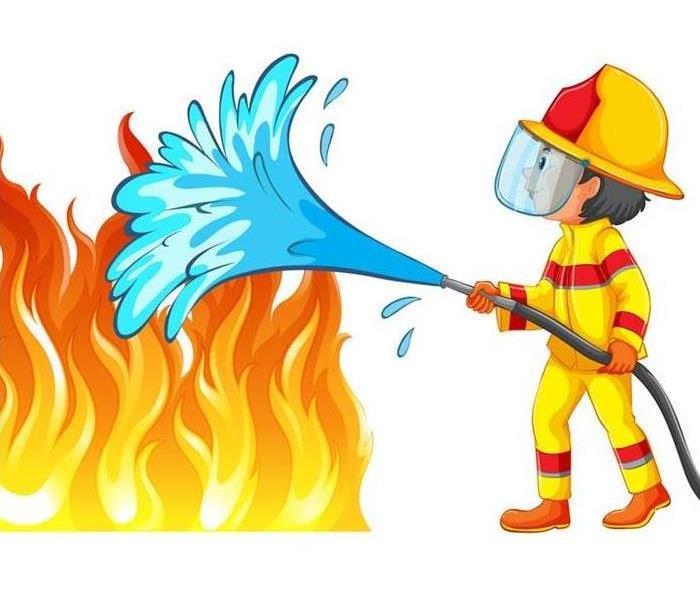 A-F tells you what fire class products start and how to put them out.
A-F tells you what fire class products start and how to put them out.
Fires can be classified into different categories based on the materials involved, providing valuable information about their causes and behavior. Here are the various classes of fires:
Class A - Fires involving solid materials like wood, paper, or textiles. These materials absorb energy from external ignition sources and can ignite through conduction, convection, radiation, or internal heat-producing processes.
Class B - Fires involving flammable liquids such as petrol, diesel, or oils. Using water extinguishers on flammable liquid fires is not recommended as it can spread the liquid and worsen the situation. Water extinguishers are suitable for environments with large amounts of combustible materials, like warehouses or storage facilities.
Class C - Fires involving gases. These fires occur when a flammable or combustible material, combined with an oxidizer like oxygen, is exposed to heat or a temperature above the fuel's flashpoint.
Class D - Fires involving metals. During a fire, the mechanical properties of steel can deteriorate under high temperatures. Structural steel members may deform, but they regain their pre-fire properties after the fire is extinguished.
Class E - Fires involving live electrical apparatus. Although not technically recognized as 'Class E,' this term is used for convenience. Faulty electrical outlets, old appliances, or faulty cords, receptacles, and switches can cause electrical fires.
Class F - Fires involving grease. Grease fires occur when cooking oil becomes too hot, reaching its smoking point and eventually catching fire. Most vegetable oils have a smoking point around 450°F, while animal fats like lard or goose fat will start smoking around 375°F.
In the event of a fire and requiring emergency services, please contact SERVPRO of Dubuque. Our dedicated team will swiftly respond to make the situation "Like it never even happened."
Water Damage from Flooding
5/23/2023 (Permalink)
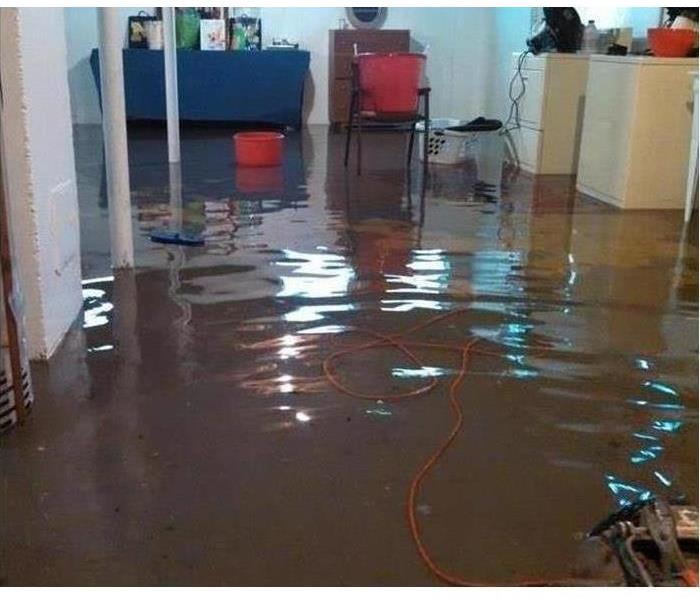 This flooded basement could be from a storm, hurricane, excessive rain, or snow.
This flooded basement could be from a storm, hurricane, excessive rain, or snow.
Don't assume that your home or business is immune to water damage because it's more common than you might think. According to FEMA, water damage from floods is one of the most prevalent and costly hazards in the United States. In fact, recent statistics from the NFIP (National Flood Insurance Program) indicate a 1 in 4 chance of experiencing a flood in high-risk areas over the course of an average 30-year mortgage.
Floods can be caused by various factors, including thunderstorms, tropical storms, hurricanes, excessive rain, and snow. Additionally, floods can occur due to overloaded or clogged sewage and drainage systems, urbanization (such as extensive paving), and dam failures, among other reasons. They can happen rapidly or develop slowly over time.
The health and safety risks associated with water damage from floods are numerous. If water is not promptly cleaned up, the following risks can arise:
- Structural damage to buildings
- Electrical damage, often resulting in power loss for days or even weeks
- Health hazards and diseases stemming from standing water
- Contaminated drinking water
- Inoperative drainage and sewage systems
- Disrupted communication channels
- Destruction of roads and bridges
- Landslides
- Ruined crops
- And much more, including loss of life
The loss of life is the most devastating consequence of flood damage. Flash floods, in particular, are the leading cause of weather-related fatalities in the U.S., affecting both people and animals alike.
Flood victims also face significant emotional hardships. Dealing with the aftermath of a flood can lead to anxiety, depression, fear, anger, frustration, sadness, and grief. These emotional symptoms can strain relationships, disrupt sleep patterns, reduce appetite, and have other detrimental effects. That's why mental health professionals are often available during disaster responses by organizations like FEMA and the Red Cross.
Property damage is another significant aspect of flood-related incidents. While wind and lightning can cause considerable harm, water damage accounts for ninety percent of the damage caused by natural disasters. Homes, businesses, vehicles, belongings, and equipment are all vulnerable. Even a few inches of water can result in severe damage to the contents of a building, not to mention the structures and land. It can take years for affected communities to rebuild and return to normalcy.
When it comes to water damage, time is of the essence. Damage and losses caused by seeping water require swift action. Delaying water damage cleanup only prolongs the inevitable. Act promptly to mitigate the effects and prevent further harm to your property and belongings.






 24/7 Emergency Service
24/7 Emergency Service








